Normal Male Reproduction (Richter)
1/59
Earn XP
Description and Tags
Richter
Name | Mastery | Learn | Test | Matching | Spaced |
|---|
No study sessions yet.
60 Terms
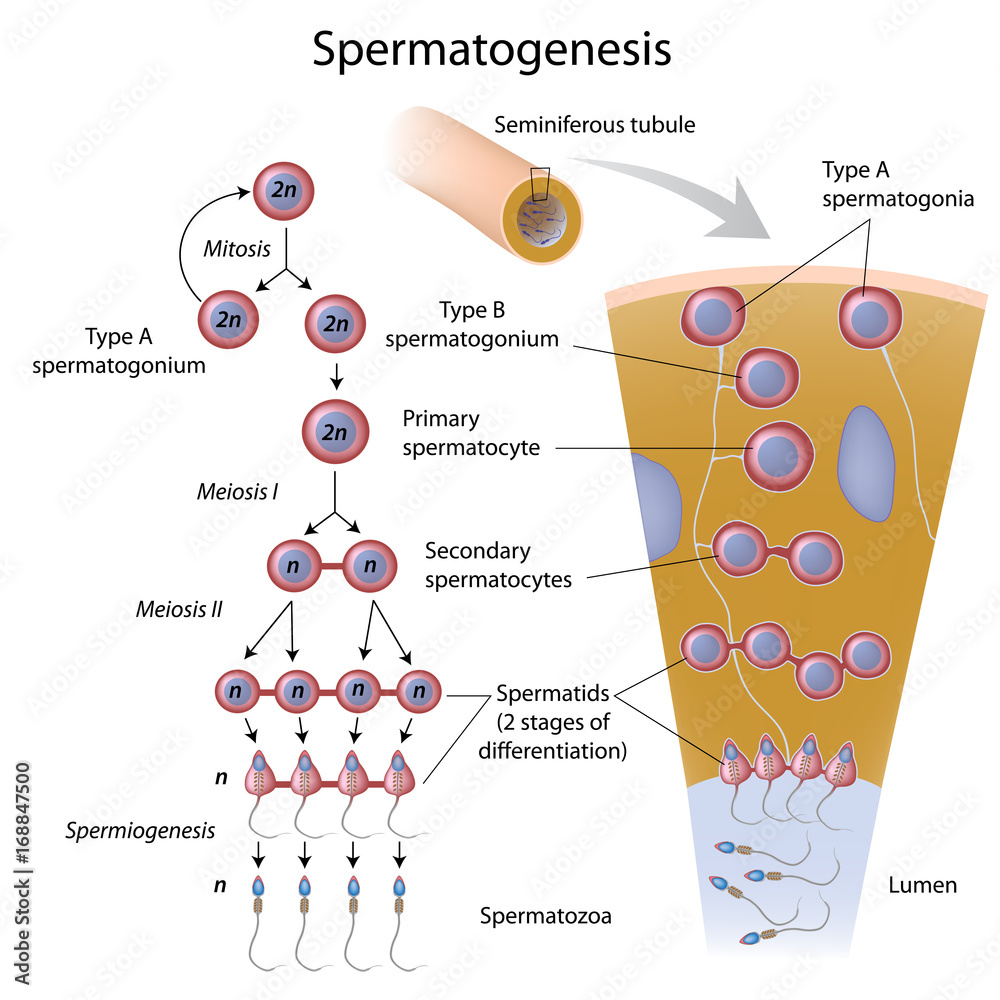

Spermatid to spermatozoa
Spermiogenesis
Blood testis barrier is formed by ____ cells and protects the ____ cells
Sertoli cells
germ cells
The __ chromosome determines sex
Y
XXY, male, low testosterone, reduced fertility/infertility
Klinefelter syndrome
X0, female, results from a missing or incomplete sex chromosome.
Symptoms include short stature, delayed puberty, infertility, heart defects, and certain learning disabilities.
Treatment involves hormone therapy. Fertility treatment may be necessary for women who want to become pregnant.
Turner syndrome
Gonads are indifferent up to __ weeks of gestation. Gene products of the SRY (sex-determining region of the Y chromosome) locus drive the development of male gonads.
5
Sertoli cells begin to secrete ___________ leading to regression of the ______ duct (the precursor of female reproductive structures)
Anti-Mullerian Hormone (AMH)
Mullerian
Testosterone (converted to dihydrotestosterone) promotes growth of _____ ducts into male reproductive structures (epididymis, vas deferens, etc.)
Wolffian
In absence of AMH, Mullerian ducts develop into female reproductive structures (no _______ required)
hormone
In females Wolffian ducts regress at __ weeks due to lack of testosterone
10
In females, after __ weeks, X chromosome is activated and initiates oogenesis
9
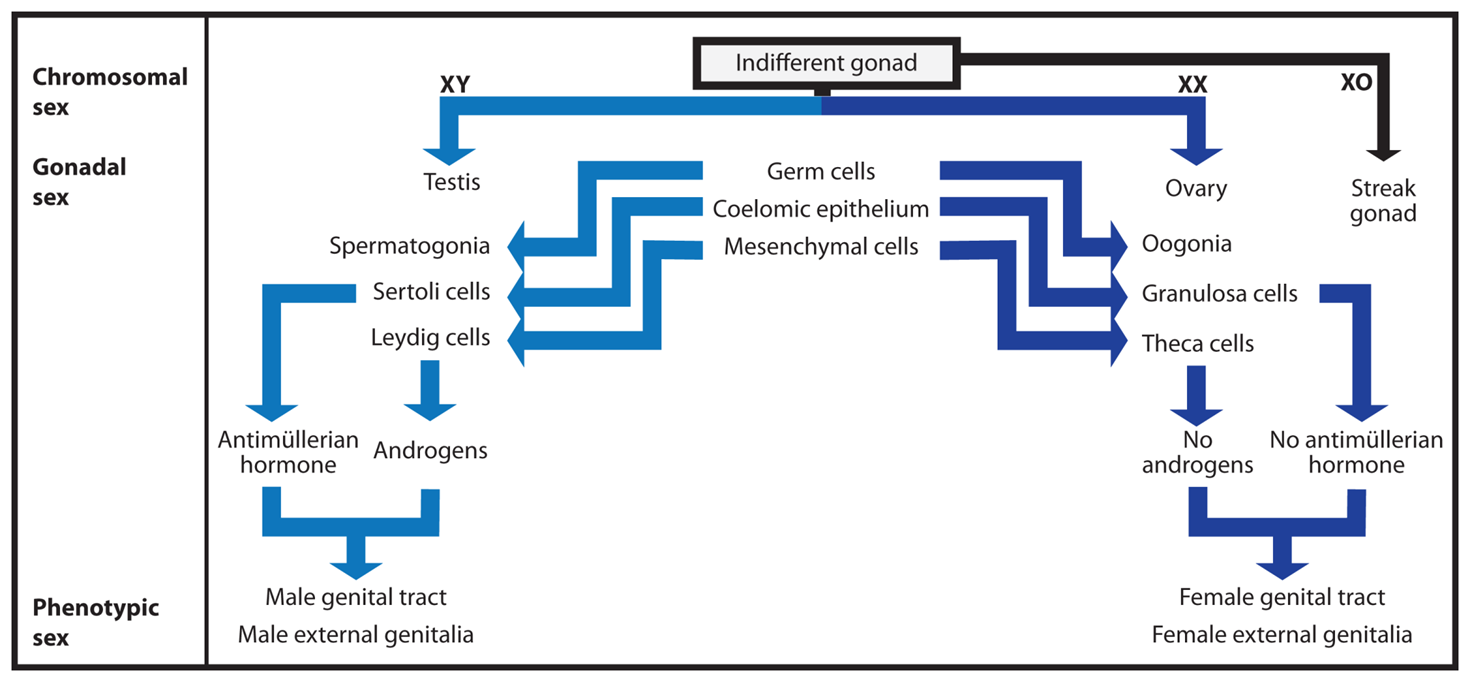
Sexual differentiation slide
Sertoli cell female counterpart
Granulosa cells
Leydig cell female counterpart
Theca cells
maintains Sertoli cell function required for initiation and maintenance of spermatogenesis.
FSH
_____ cells produce androgen binding protein (ABP) which binds testosterone and enables high concentrations of testosterone to accumulate in the testis.
Sertoli
Responsible for testosterone synthesis.
Leydig cells
Leydig cells have high expression levels of _________, one of the rate-limiting enzymes in testosterone synthesis.
17-beta-hydroxysteroid dehydrogenase
stimulates testosterone production in Leydig cells
LH
Both testosterone (and dihydrotestosterone or DHT produced in peripheral tissues by 5-alpha-reductase) are necessary for _________ and are responsible for all aspects of male sex characteristics
spermatogenesis
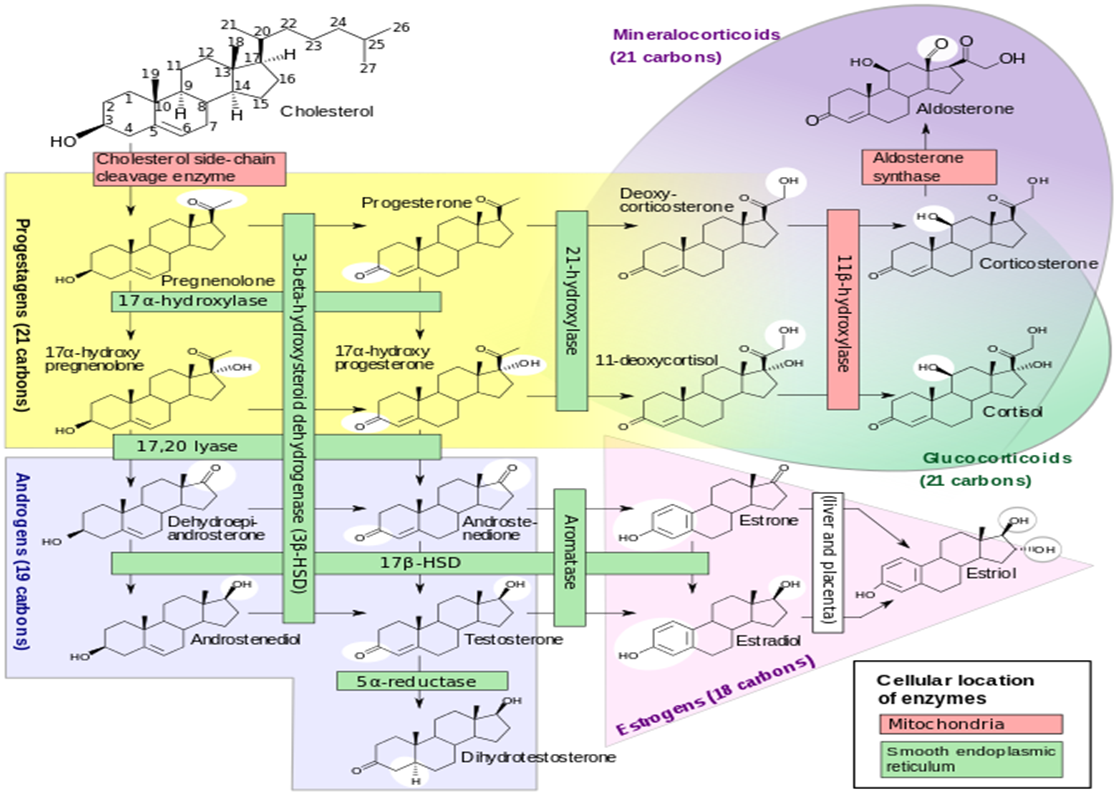
Testosterone production
Cholesterol side chain cleavage enzyme is in the inner mitochondrial membrane
Increase cholesterol to inner mitochondrial membrane, increase
steroid synthesis because cholesterol side chain enzyme can access more substate
DHT has a _____ half-life compared to testosterone but is _____ potent
Short
More
Testosterone → DHT
5 alpha reductases (periphery)
Androstenedione → testosterone
17 beta - HSD (Leydig cells)
Testosterone binds to _________ synthesized by Sertoli cells, which allows high accumulation of testosterone in testis.
Androgen Binding Protein
Testosterone is transported in blood bound to ______ or _______
SHBG (Sex hormone-binding globulin; similar to ABP) or albumin.
Androgen receptor is a _______ receptor
Nuclear
Testosterone can be converted in target tissues to dihydrotestosterone (DHT; by 5-α reductase) or _______ (by aromatase).
estradiol
Gonadotropic hormones FSH and LH are released from the
anterior pituitary
LH couples to G_ receptors
Gs leading to adenylyl cyclase, cAMP, PKA, transcription of enzymes that synthesize tessosterone
LH binds to the Leydig-cell’s LH-receptor, a seven transmembrane receptor, which couples to G_ thereby increasing _______ production to stimulate testosterone synthesis.
Gs
cAMP
cAMP/PKA-signaling induces _______, which promotes transport of cholesterol to the side-chain-cleavage enzyme (SCC) located in the inner mitochondrial membrane, which is a rate-limiting step in testosterone synthesis.
StAR (steroidogenic acute regulatory protein)
promotes transport of cholesterol to the side-chain-cleavage enzyme (SCC) located in the inner mitochondrial membrane
StAR (steroidogenic acute regulatory protein)
FSH stimulates a seven transmembrane receptor coupled to G_ and _____ in the Sertoli cell, to stimulate the expression of aromatase, ABP (androgen binding protein) and growth factors necessary for spermatogenesis and Sertoli cell function.
Gs and cAMP
Testosterone moves through the basal lamina into Sertoli cells where it has two fates: one, to exit into the __________ where it binds to androgen binding protein (ABP) and regulates spermatogenesis, or two, to be converted to estradiol 17-beta by _______.
seminiferous tubules lumen
aromatase
the half-life of LH is __ min, while that of FSH is _ h.
30; 2
______ release of GnRH from hypothalamic neurons promotes LH and FSH expression and release in the anterior pituitary.
Pulsatile
GnRH is a peptide acting on GnRH receptors that are coupled to G_/___ signaling.
Gq/PLC
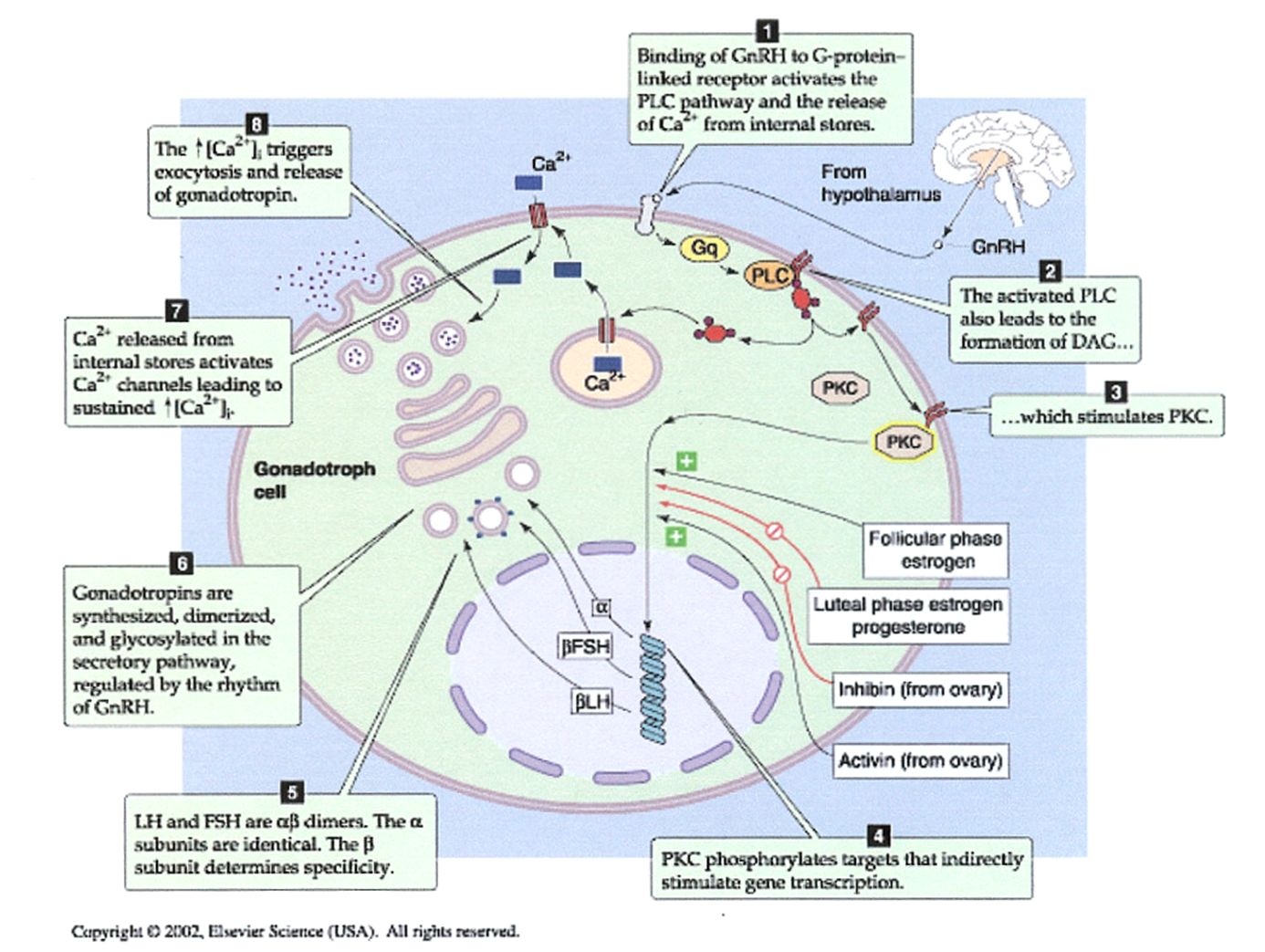
How GnRH stimulates LH and FSH production and release
In males, FSH stimulates the expression of _______ in Sertoli cells which blocks expression/secretion of FSH in pituitary gonadotrophs
Inhibin B
LH increases testosterone production. Circulating testosterone, blocks _____ release from the hypothalamus as well as LH expression in the pituitary.
GnRH
Inhibin decreases ____, testosterone decreases ____ and ____
FSH
FSH and LH
•In utero development of male reproductive tract
•Increases muscle mass at puberty
•Regulates liver lipoprotein profiles
•Promotes male fat distribution
•Thickens vocal chords
Testosterone predominant
•Growth of penis and scrotum
•Growth of facial hair
•Increase prostate growth (prostate hyperplasia)
•Male pattern baldness
DHT predominant
•Growth and development of male genitalia and reproductive structures (vas deferens, epididymis, glands, etc.)
•Sperm production
•Libido
“Survival of the species”
Testosterone and DHT
Testosterone is also converted to _____ in peripheral tissues, especially adipose tissue, bone or brain
Estrodiol
______ tissue supplies much of the estrogen found in males.
Adipose
Sperm production
Feedback suppression of gonadotropin secretion
imprint male pattern of gonadotropins, sex drive, behavior
Function of estradiol in males
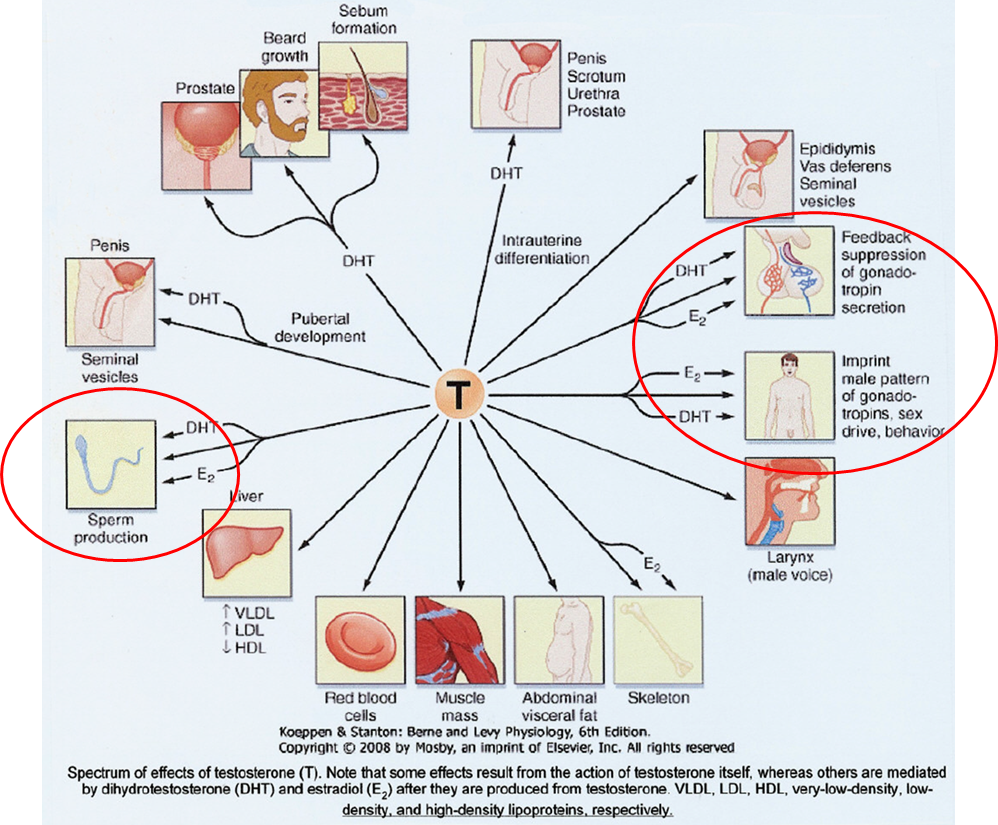
Function of Testosterone
DHT
Estradiol
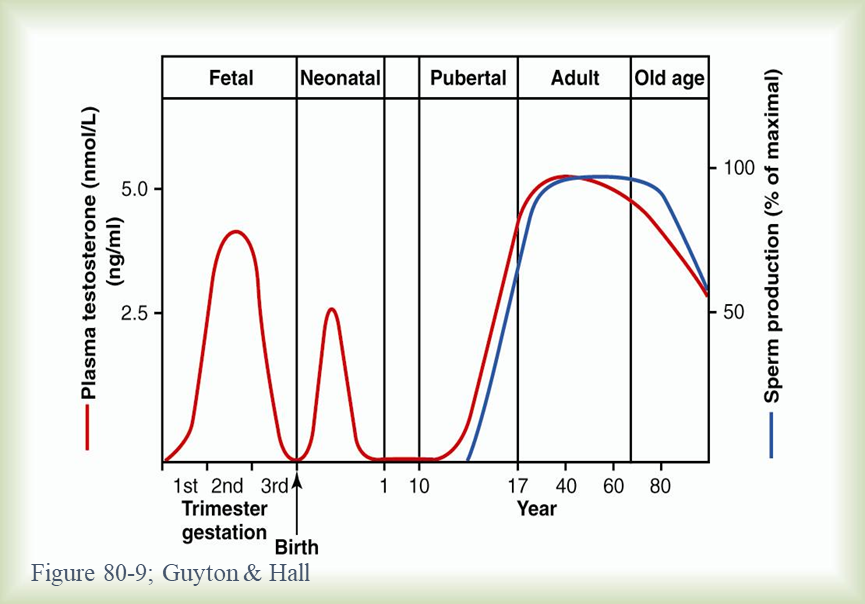
Age related changes in male gonadal function
Leydig cells are very active in both fetal and neonatal life and ______ is necessary for the differentiation of male reproductive structures.
testosterone
Age ___-____: GnRH secretion is low; testes are quiescent; androgen levels low.
1-10
Age ___-___: pulsatile GnRH secretion begins; LH and FSH are released in higher concentrations.
10-12
Age ____-___: puberty begins; testosterone levels rise and secondary sex characteristics begin to develop.
12-14
Age ___-___: testosterone levels reach maximum.
18-20
Age __ and beyond: Generally, testosterone levels decline approximately 10% per decade.
40
Male _____ may be maintained into the 7th (and 8th) decade of life due to presence of testosterone
fertility
The period of androgen deficiency is called
Andropause